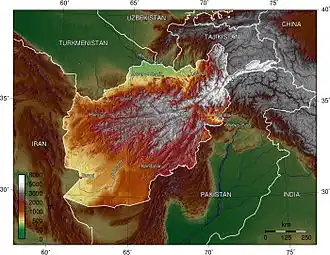
Afghan emigration is the historical process whereby people have left Afghanistan and settled in other countries abroad. There is no distinct Afghan ethnic group. Instead the country is primarily made up of Pashtuns, Tajiks, Hazaras and Uzbeks who come from a mix of Iranian, Turkic and Mongol backgrounds. These people have emigrated from Afghanistan in very large numbers over the last fifty years, driven by a succession of crises in Afghanistan. These began with the invasion of the country by the Soviet Union in 1979, continued through the civil wars of the 1990s and the rise of the Taliban, and culminated in the US invasion of the country in 2001 and a twenty-year failed experiment in trying to socially engineer the country, only to have the Taliban reclaim power in 2021. Millions of Afghans migrated into Iran and Pakistan as a result of these crises. Millions more went further afield. For instance, there are over half a million Afghans in the Arabian Peninsula in countries like the United Arab Emirates (UAE) and Saudi Arabia. Western countries like the United States, Germany, Canada and France host Afghan communities running into the hundreds of thousands, while nations like the United Kingdom, Sweden, Australia, Austria and the Netherlands each have sizeable Afghan communities of between 40,000 and 80,000. Afghan emigration has been one of the largest national emigrations of the late twentieth and early twenty-first centuries.[1]
Research your ancestors on MyHeritage
Afghan emigration chronology of eventsAfghan emigration chronology of events
When examining any wave of emigration it is important to establish if one is assessing a national emigration or an ethnic emigration. For instance, the Kurdish ethnic people have emigrated far and wide since the early twentieth century owing to persecution that they have experienced in Turkey, Iraq and other countries along the northern rim of the Middle East. They are a people without a land and this is a clear example of a form of ethic emigration. In other cases people of different ethnicities who are bound together by their national identity have emigrated in large numbers.[2]
Afghanistan is a good example of the latter. The country is not ethnically homogenous. There is a large array of different ethnic groups in the country, notably the Pashtuns, an Iranian people who make up about 40% of the population. Tajiks, Hazaras and Uzbeks make up the bulk of the rest of the population, though there are small groups of additional ethnicities as well such as Turkmen, Balochs and Aimaqs. These ethnicities are generally either Iranian, Turkic, Mongol, or a mix of two or more of these. The diverse ethnic landscape reflects Afghanistan’s position at the crossroads of Asia, a land which connected Central Asia and the Middle East to the west with the Asian Steppe and China in the east. When we speak of Afghan emigration we are consequently examining the migration of these different groups, not as ethnic groups, but as a national people.[3]
The country of Afghanistan with its current borders is a modern phenomenon. Prior to the nineteenth century parts of the country were often ruled by outsiders and it is not possible to evaluate Afghan emigration in the modern sense until the country took on its modern shape. Once the modern-day country of Afghanistan emerged in the course of the eighteenth and nineteenth centuries emigration remained limited for a time. Britain regularly tried to conquer the country in the nineteenth century but failed and Afghanistan remained broadly independent into the twentieth century. Moreover, the heavily landlocked nature of Afghanistan meant that people did not leave the country to go and live in places like the United States and Britain, as Indian, Chinese and Japanese people did from the middle of the nineteenth century onwards.[4]
Modern Afghan emigration really began in the 1970s as a wave of crises struck Afghanistan. This began with the Saur Revolution of 1978 which brought a communist regime to power. A year and a half later, in the final days of 1979, the Soviet Union invaded Afghanistan in order to prop up the deeply unpopular communist government. The Soviet-Afghan War lasted for most of the 1980s and led to the flight of large numbers of Afghans over the borders into Pakistan and Afghanistan. The Soviet withdrawal at the end of the 1980s meant that the Afghan communists were only able to remain in power for a brief period of time into the early 1990s before they were overthrown by various mujahidin religious armies and other groups.

The overthrow of the Afghan communists did not bring the violence to an end. It simply changed the complexion of it. In 1992 a series of civil wars began which eventually brought the Taliban to power. However, even they never acquired full and complete control over the country and as late as 2001 the Northern Alliance remained in command of stretches of the north of the country. That was the year of the 9/11 attacks on New York City orchestrated by a Saudi Arabian mujahidin who had fought in Afghanistan in the 1980s, Osama bin Laden, and his Al-Qaeda terrorist organization. The attacks led to the US invasion of Afghanistan in response in October 2001 and a further wave of emigration from Afghanistan.[5]
Despite their clear military superiority, the Americans and their allies from Britain and other countries were never able to fully secure control over Afghanistan or completely defeat the Taliban. Hence, the country remained mired in an insurgency conflict year after year and hundreds of thousands of Afghans continued to emigrate over the borders or seek refuge further afield. Eventually, in 2021, twenty years after they arrived, the Americans pulled out of Kabul in a chaotic manner and the Taliban returned to power. This led to a new wave of Afghan emigration yet again. Today there is a movement within neighboring countries like Iran and Pakistan to have hundreds of thousands of Afghan migrants in their countries return home after years or even decades of foreign residence.[6] That being said, Afghanistan is desperately poor, the Taliban is facing regional insurgencies yet again, and there is a constant risk of famine conditions developing in the localities. Therefore the modern story of Afghan emigration is far from over and new large waves of Afghan movement might well occur into the future as events unfold.
Extent of Afghan emigrationExtent of Afghan emigration
As soon as the crises began in Afghanistan in the late 1970s millions of Afghans began moving. Much of it was internal to begin with. The population of the capital, Kabul, swelled from around 600,000 people to nearly two million following the Soviet invasion as people sought safety there. Most of it was external though.[7] A first huge wave of migration took place over the southern and western borders to Iran and Pakistan. This has been followed by periodic further waves of refugees ever since. Another occurred at the end of the 1980s as the Soviets withdrew from the country and supporters of the now fatally weakened communist government began streaming out of Afghanistan. Third and fourth waves followed in the 1990s owing to the civil wars that brought the Taliban to power and a famine which gripped the country. It has all continued through the early twenty-first century.[8]
Millions of people settled in Iran and Pakistan as part of these waves of emigration. Precise records are not available. Nobody was at the borders counting the number of people leaving the country in 1980 or 1989 or 1995 or 2001. Instead demographers have relied on estimates of the Afghan community in places like Pakistan and Iran after they have arrived and settled to estimate the scale of emigration. For instance, it is understood that well in excess of three million Afghans have permanently settled in Pakistan since the crises began at the end of the 1970s. These in turn have had children born in Pakistan of Afghan heritage and the number of Afghans in Pakistan is probably around four million today. It is an ever-changing picture though as changes in the political situation in Afghanistan over the decades have led some people to leave and some people to return. Most of the Afghans in Pakistan are found in the northern province of Khyber Pakhtunkhwa.[9] One-in-five people in the city of Peshawar, a city with two million inhabitants, are of Afghan heritage.[10]

Slightly fewer Afghans have fled to Iran as a result of the ongoing crises since the Soviet invasion in 1979. A conservative estimate places the number of Afghans in Iran at two million, though it may be considerably higher. However, the Afghan émigré community in Iran is less transient. More people tend to stay permanently and this has led to a higher degree of natural increase in Iran than has occurred in Pakistan. Many Afghani refugees in Iran drifted to Tehran and the capital city is home today to at least half a million Afghans.[11]
A complicating factor is that there is sometimes an ethnic dimension to this migration, as some countries have been more welcoming of certain Afghan ethnic groups than others. For instance, Pakistan has been more welcoming of ethnic Pashtuns from Afghanistan over the decades, as Pashtuns are a prominent ethnic group within Pakistan itself. However, they have been less willing to allow the widespread entry of groups like the Uzbeks and Hazaras. Similarly, Iran has been reluctant at times to allow the entry of Balochs from Afghanistan. This is because Iran has a Baloch minority in the southeast of the country that have expressed separatist sentiments for decades and are engaged in a low-level insurgency. Iran has consequently been reluctant to take in additional ethnic Balochs from neighboring Afghanistan for fear of their presence compounding the Iranian Baloch separatist problem. The same is true of the Baloch minority in south-western Pakistan.[12]

Beyond Iran and Pakistan, Afghans have emigrated to many western countries and places in the Middle East. There are an estimated 300,000 Afghans in the United Arab Emirates today and they have made a large contribution to the construction sector and other industries in Dubai and Abu Dhabi during an era when the Gulf country has become a regional economic powerhouse. Many countries, like the United States and Britain, which were involved in the invasion of Afghanistan in 2001 and the failed attempt to socially engineer the country in the two decades thereafter, have also taken in large numbers of Afghan emigrants, particularly people who aligned themselves with the western government. In the US the Afghan community is concentrated in states such as California, Texas, Virginia and New York.[13]
Demographic impact of Afghan emigrationDemographic impact of Afghan emigration
The demographic impact of Afghan emigration over the last half a century has been vast. No region has been more impacted on by it than northern Pakistan, as cities like Peshawar have been inundated by Afghan migrants in waves since the late 1970s. However, the long-term impact of this migration is hard to define. As of 2025 there is a strong government drive in both Pakistan and Afghanistan to coerce millions of Afghans into returning to Afghanistan now that the Taliban are back broadly in control of the country. These are tendencies that are visible across the Middle East and Central Asia. For instance, Turkey is also encouraging the millions of Syrians it has hosted since the mid-2010s as a result of the Syrian Civil War to return home now that the conflict appears to be over. Still, no matter how many Afghans might eventually return to Afghanistan, a very sizeable number have laid down permanent roots in Pakistan and Iran and have forever changed the demography of places like northern Pakistan and north-eastern Iran.[14]

Elsewhere the demographic impact will probably be much more permanent. There are substantial Afghan communities running into the tens or hundreds of thousands in countries as geographically diverse as the United States and Canada in North America, the United Arab Emirates, Qatar and Saudi Arabia in the Middle East, and Germany, Sweden, France, Britain, Austria and the Netherlands in Europe. Decades from now, people in these countries will be able to trace their genealogical story back to Afghan ancestors who left Afghanistan during one of the crises that began all the way back in the late 1970s.
See alsoSee also
Explore more about Afghan emigrationExplore more about Afghan emigration
- Afghanistan’s Refugees: Forty Years of Dispossession at Amnesty International
- Afghanistan: Conflict and Displacement 1978 to 2001 at Forced Migration Review
- Instability in Afghanistan at Council on Foreign Relations
- Afghanistan: Past Conflicts, 1979-2001 at European Union Agency for Asylum
- A Historical Timeline of Afghanistan at PBS
References
- ↑ https://www.migrationpolicy.org/article/afghan-refugees-iran
- ↑ https://www.washingtoninstitute.org/policy-analysis/addressing-inequality-and-despair-driving-kurdish-migration-europe
- ↑ https://www.worldatlas.com/articles/ethnic-groups-of-afghanistan.html
- ↑ https://www.pbs.org/newshour/politics/asia-jan-june11-timeline-afghanistan
- ↑ https://www.iwm.org.uk/history/afghanistan-war-how-did-911-lead-to-a-20-year-war
- ↑ https://www.rferl.org/a/iran-pakistan-deportation-afghan-migrants/33465419.html
- ↑ https://www.refworld.org/reference/countryrep/writenet/1996/en/96430
- ↑ https://www.bpb.de/themen/migration-integration/regionalprofile/english-version-country-profiles/292271/afghan-refugees-in-pakistan/
- ↑ https://reliefweb.int/report/pakistan/barriers-access-education-afghan-refugees-khyber-pakhtunkhwa-kp-pakistan
- ↑ https://www.jstor.org/stable/42909163
- ↑ https://euaa.europa.eu/news-events/euaa-reports-situation-afghan-refugees-iran
- ↑ https://www.theguardian.com/world/2024/jan/18/where-balochistan-why-iran-pakistan-strikes
- ↑ https://www.ebsco.com/research-starters/ethnic-and-cultural-studies/afghan-americans
- ↑ https://www.unhcr.org/ie/news/stories/afghan-refugees-forced-return-face-uncertain-future

